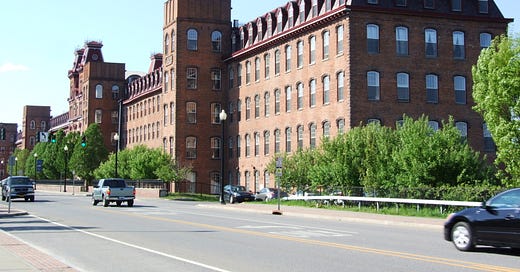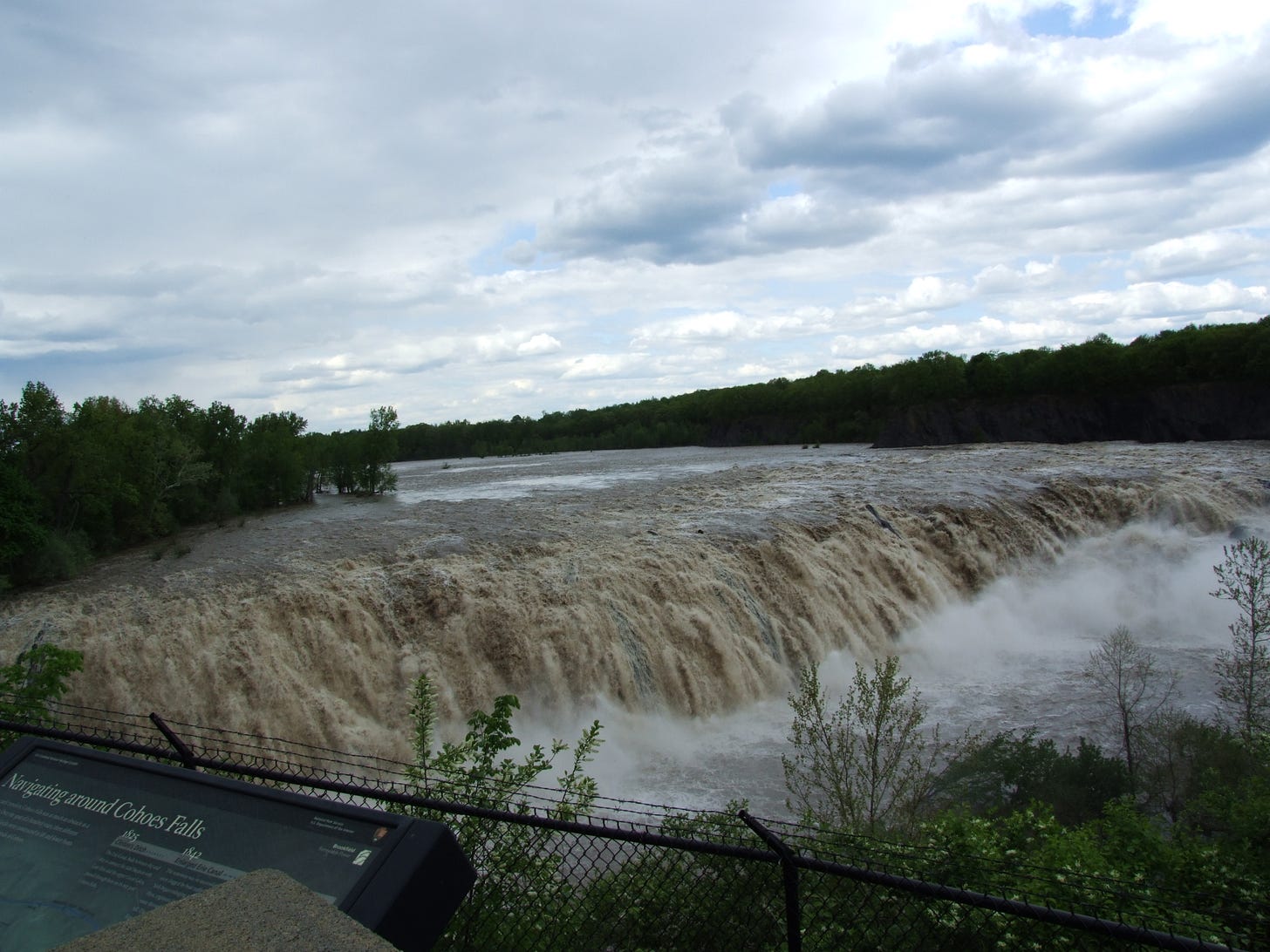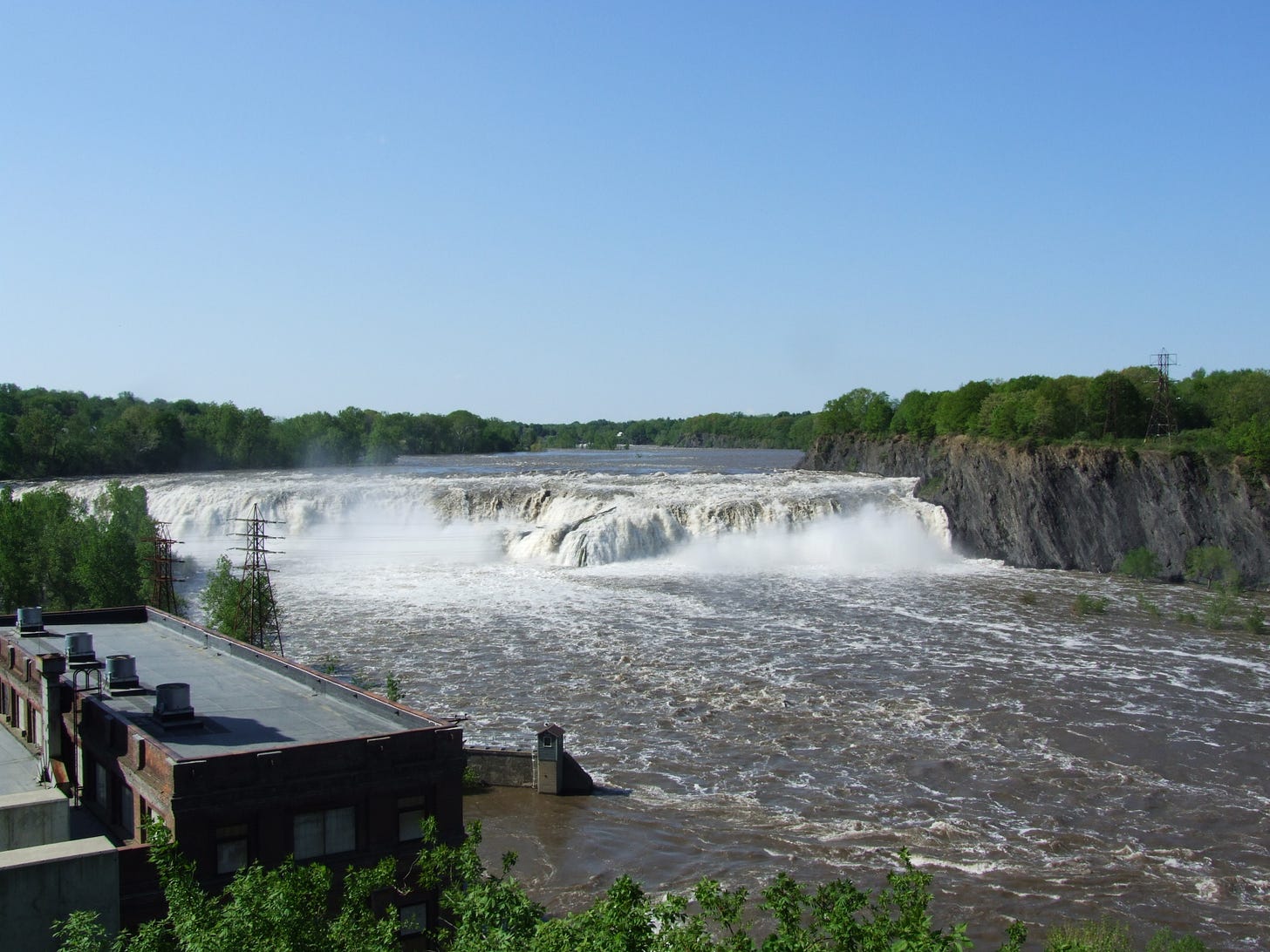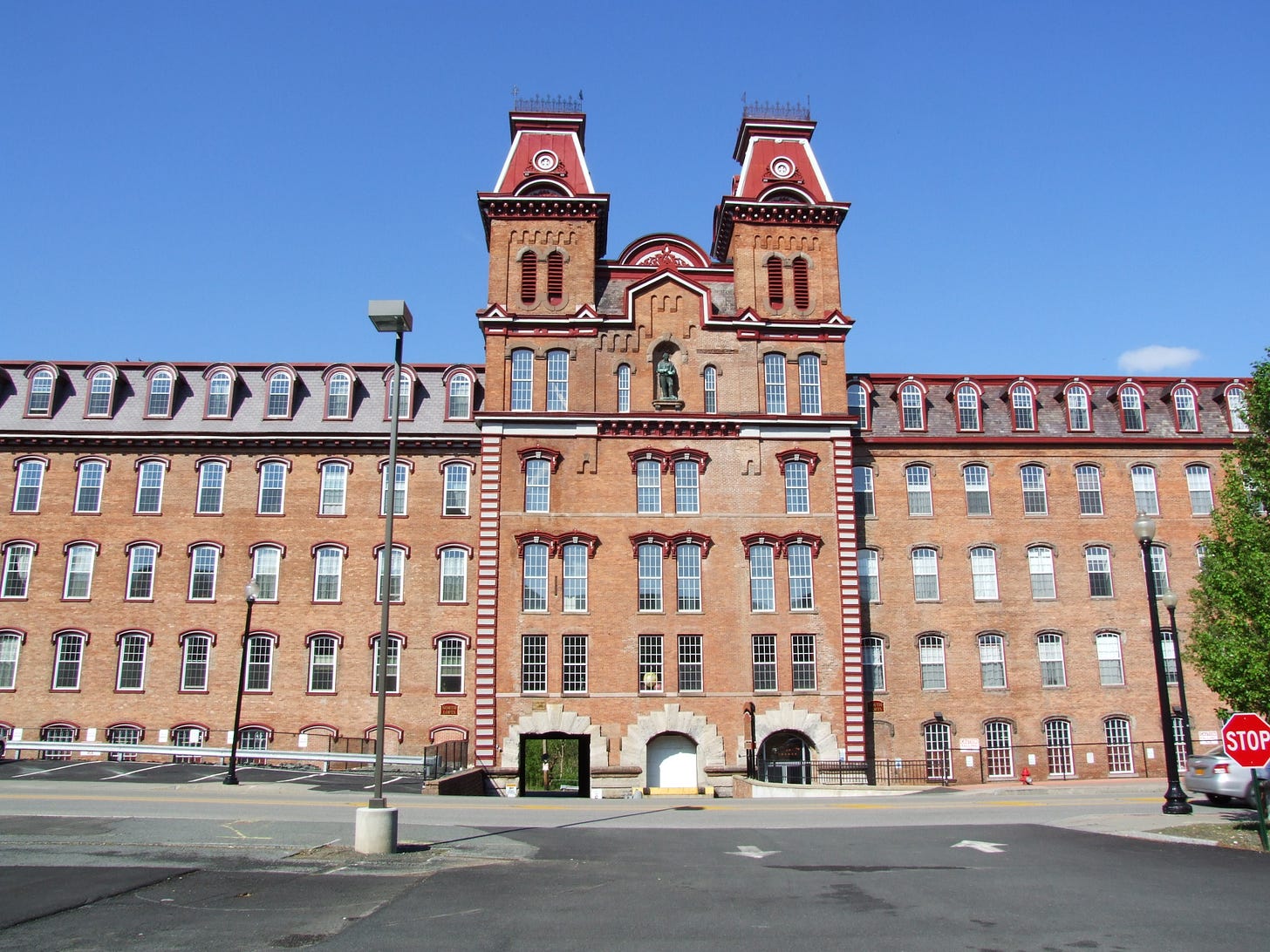Mastodon Mill: The Harmony Mills Story
One of the architectural and engineering wonders of the Capital Region.
(Driving up North Mohawk and encountering Harmony Mill # 3. Photo: Suzanne Spellen)
Harmony Mills and the Cohoes Falls are so big, and so important to the region and its history, they deserve a big coverage. This story constitutes this week’s posts.
The first time I visited Troy, it was to see a property that I had found on line. My friend Debora and I were planning to relocate somewhere out of Brooklyn and we had picked Troy for various reasons. We had never been here before and knew nothing about the city or the area. When we got to the property, a wonderful church rectory, we could see that it was within blocks of the Hudson River, and that there was a large 19th century brick factory building near the river, right in front of our river view. It was one of several large 19th century former garment factories that lined River Street between downtown and North Central, where we were. These factories were the remnants of Troy’s once-bustling collars and cuffs trade, a powerful and huge industry that helped make Troy one of the most prosperous cities in the United States. The building at the time was empty, with broken and boarded up windows, and looked rather forlorn. It was the Marshall Ray building on River Street.
Our real estate agent was quick to tell us that the factory had been purchased by the same developer who had purchased and rehabbed a factory complex called Harmony Mills, just across the river in Cohoes. He planned on doing here what he had done in Cohoes, transforming the factory into loft-style apartments. He assured us that buying the building we were interested in would become a doubly valuable proposition, being that it was so close to this upscale lofts-in-the-making. We DID know about Harmony Mills, didn’t we? We mumbled something about having heard of it, (not) and the day went on. We ended up buying another property, and the renovation of the Marshall Ray building didn’t take place for another eight years, by a different developer. But that’s another story. Probably two stories.
I’d always been curious as to what Harmony Mills was all about, but for some reason never looked it up. After being in Troy for almost two years, one weekend, I decided to look for it. I’d been to Cohoes (the accent is on the second syllable) a few times, so I knew where Harmony Mills was not. It wasn’t downtown. I knew it was on the river, so there’s where I would start. I also knew that the mill was on the Mohawk River, not the Hudson, and that it was near the historic Cohoes Falls. The Mohawk and the Hudson came together right below the mill somewhere, so I was just going to drive around until I found it. How can you miss a waterfall? Or a mill?
Sometimes it’s better to go exploring with a wealth of information read beforehand or a guidebook. Other times there is nothing like coming up on something you didn’t expect to be there, and being blown away. I followed the Mohawk and was totally blown away. But a little back story and short history is needed here.
If you cross over the river to Cohoes from Troy at 112th Street, you cross a long Art Deco-style bridge over the Hudson River. Then you traverse the width of Van Schaick Island, which sits in the middle of the two rivers. After the island is another bridge, this one crossing the Mohawk, there’s another much smaller island, this one only a couple of blocks wide, another bridge over the Mohawk again, and then you are in the city of Cohoes.
The histories of the two cities are intertwined. The riverbanks of both cities allowed for the building of large textile and garment factories, and while Troy was known for detachable collars and cuffs, and the shirt business, Cohoes was known for its mills that produced millions of yards of cotton goods and fabrics. Troy is the “Collar City”, and Cohoes is the “Spindle City.” And did they ever know how to spin.
The Hudson is a relatively calm river, but its cousin, the Mohawk, goes berserk right above Cohoes, resulting in the Cohoes Falls, produced by millions of gallons of upstate water spilling down a 70 foot drop into a deep gorge. The Mohawk people who lived here centuries ago discovered the falls and called them “Ga-ho'n'-yoos” which was translated, most appropriately, “Place of the Falling Canoe.” In Iroquois oral history, this was the place the Great Peacemaker convinced the Mohawk Nation to lead the great Iroquois Confederacy. The Mohawks lived in this area for centuries until the Dutch showed up in the early 1630s.
In 1632, merchant Killiaen Van Rensselaer set himself up as a “patroon,” a Dutch feudal-style overlord, and claimed much of what is Rensselaer and Albany counties as his own, thousands of acres, creating the manor of Rensselaerwyck. That included the entire area that makes up most of Cohoes and Troy. He leased out his land to farmers and settlers, and over the next century or so, the land slowly was settled, starting with Van Schaick Island, which was beyond the falls, and much easier terrain to farm and build on.
You can’t talk about the history of this area without talking about the rivers. They formed the history of Troy, Cohoes, Albany and other cities and towns in the Capital District and made great industries possible. Water power and transportation, these were key. European, and later American entrepreneurs recognized that the Cohoes Falls could be harnessed for power. Water power had been used in Dutch mills for centuries, and as technology improved over time, water power could run machines to power the modern industry of the day. But first came the Erie Canal.
The Erie and Champlain canals were begun in 1817. The Champlain Canal was completed in 1823 and the Erie Canal in 1825. They join in Waterford and eastern Cohoes and then open up onto the Hudson River. This enabled goods and people to travel from New England, the Great Lakes, Canada and the western United States to New York City, the Eastern Seaboard and the world beyond. This canal system is one of the most important developments in the history of the United States.
There was no way anyone was going to make the falls viable for barge traffic, so they cut the canal around the falls, bypassing the cataract entirely. The Cohoes Company was founded to develop the power capability of the falls. They began building dams above the falls, the first one in 1831. That one was destroyed by ice, so they had to build another one a year later. Two canals were diverted from the river to power the industry that was already starting to grow. The company would soon end up controlling all of the power of the Mohawk River from half a mile above the falls to a mile below.
Like Troy, Menands and West Troy, (now Watervliet) the iron industry took root here, and for a while, in the early 19th century, the town’s foundries were humming. The Simmons Ax Company and the Cohoes Foundry were active and successful iron businesses. But textiles would define the city, beginning with the first cotton mill, the only one in Albany County, which opened in 1817. It was called the Cohoes Manufacturing Company. They burned down in 1829, and did not reopen.
In 1832, Egbert Egberts, Timothy and Joshua Bailey opened a knitting mill. Egberts & Bailey was the first mill in Cohoes to utilize the water power provided by the Cohoes Company. They perfected the water powered knitting machine, giving rise to a new industry in the United States. Cohoes would become a major city in the production of cotton and woolen knit goods, especially stockings and long underwear, into the 20th century. Then, in 1836, a man named Peter Harmony established the Harmony Manufacturing Company.
Ok, mighty waterfalls, dams, power plants, factories and mills – got it.
Knowing all of that does not prepare you for what’s coming when you drive or walk up North Mohawk Street towards Harmony Mills and the Cohoes Falls. On my first trip, before I read any of the history I just told you, I’m looking forward to seeing some nice factory buildings. I really like industrial architecture, and have long harbored fantasies of living in a loft, so I’m ready.
As I approach the Mill, the street starts to go steeply uphill. The first building I see on the left is a large and magnificent Second Empire factory building. It’s four stories, with a handsome tower at the front, both building and tower capped with slate mansard roofs. The factory building is a classic 19th century style, with lots of windows. It’s been converted into housing, and looks great. A sign on it says “Mill 4.” Ok, I said to myself, nice. One of the nicest factory buildings I’ve seen anywhere, certainly nicer than anything in Brooklyn. If this is “4,” three more of these would certainly be great. Uh, yeah.
Coming over the rise of the hill, I see it on the right, overlooking the Mohawk. And I keep seeing it. It stretches for blocks. And it’s magnificent and jaw dropping. It’s Harmony Mill Number 3, the main mill of the Harmony Mill complex and the biggest and most beautiful factory building I’ve ever seen in my life. I later find out that it’s 1,185 feet long and 70-76 feet wide, and five stories tall. Over a quarter of a mile from end to end. It’s the centerpiece of a mill complex that includes Mill 4 and a large group of buildings across the street. When it was completed in 1872, it was the largest textile mill in the United States, and perhaps the world.
I didn’t know that that day, I just knew the building stretched for blocks, with a tower in the middle with the same Second Empire styling as Mill 4. After you finally get past the mill and the other mill buildings across the street, there are several blocks of great looking Greek Revival worker’s housing. At the end of it, the great Cohoes Falls themselves. They had peaked after days of rain, and millions of gallons of water thundered down the precipice and into the gorge below. Islands in the river were flooded, trees peeking out of the water. The falls, the second tallest waterfalls in the state, after Niagara, were tremendous. Harmony Mill was tremendous. How could I have missed this for almost two years? You know I had to find out more.
Next time – the history of Harmony Mill. It’s full of firsts, biggest, mosts, and a tale of workers, management and industry. It’s also about engineering and technology, and the preservation and protection of our precious history and the buildings and systems that made it all possible. It could very easily have all been lost.
(Cohoes Falls in late spring. Photo: Suzanne Spellen)
Cohoes Falls, with early 20th century power plant to the left. You get an idea of the distance and scale by the one-story watch tower in the center. Photo: Suzanne Spellen)
(Standing across the street from Mill 3. It’s too big to get all of it in the frame. Photo: Suzanne Spellen







Wow, this looks amazing! I had no idea about any of this. Those mill buildings are gigantic. I imagine there are not many places this kind of loft-style living at this scale exists outside of big cities.